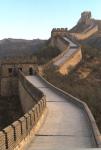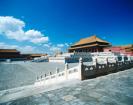No matter where you are from; no matter whether you are in China now or planning to come here; no matter whether it is the first time you have been to China; no matter what you are doing in China, a trip to China must be one of the most wonderful trips of your entire life. Chinese history, culture and customs attract many people every year.
But there must be many difficulties in front of you, with language the single most difficult barrier. Whenever you encounter difficulties, please call us at +86-13366696524 or send us an email at rebecca@chinaesl.org and we will try our best to help you.
We hope you have a wonderful time in China!
��ChinaESL your best choice!
The capital city, Beijing
As the capital of China, Beijing is one of the world's truly imposing cities, with a 3,000-year history and 11 million people. Covering 16,808 square kilometers in area, it is the political, cultural and economic center of the People��s Republic.
Rich in history, Beijing has been China��s primary capital for more than seven centuries. The old city walls have been replaced by ring roads, and many of the old residential districts of alleys and courtyard houses have been turned into high-rise hotels, office buildings, and department stores. Beijing, a dynamic city where the old and new intermingle, remains a magnet for visitors from inside and outside China. More...
GREAT WALL
The Great Wall of China, one of the greatest wonders of the world, was enlisted in the World Heritage by UNESCO in 1987. Just like a gigantic dragon, the Great Wall winds up and down across deserts, grasslands, mountains and plateaus stretching  approximately 6,700 kilometers (4,163 miles ) from east to west of China. With a history of more than 2000 years, some of the section of the great wall are now in ruins or even entirely disappeared. However, it is still one of the most appealing attractions all around the world owing to its architectural grandeur and historical significance. More...
approximately 6,700 kilometers (4,163 miles ) from east to west of China. With a history of more than 2000 years, some of the section of the great wall are now in ruins or even entirely disappeared. However, it is still one of the most appealing attractions all around the world owing to its architectural grandeur and historical significance. More...
THE FORBIDDEN CITY (Imperial Palace, Gugong)
At the city center is the imperial palace complex of 24 Ming and Qing dynasty emperors. In imperial times it was called as the Purple Forbidden City from the association of the emperors with the color of the Pole Star. Surrounded by 10 meter (32 feet) high walls and gates and a 50m (164 ft.) wide moat, it was inaccessible to ordinary people, but well populated by imperial family members, their servants and staffs, officials, and  guards. The major ceremonial buildings of the palace are aligned on a north-south axis that extends beyond the walls toward the Temple of Heaven complex and Yongding Gate in the south. The main entrance to the palace complex is via the Meridian Gate (Wumen), from which the New Year was announced each year by the emperor, proclamations were read, and the fate of prisoners decided. More...
guards. The major ceremonial buildings of the palace are aligned on a north-south axis that extends beyond the walls toward the Temple of Heaven complex and Yongding Gate in the south. The main entrance to the palace complex is via the Meridian Gate (Wumen), from which the New Year was announced each year by the emperor, proclamations were read, and the fate of prisoners decided. More...
TIANANMEN SQUARE
Just south of the Forbidden City is Tiananmen Square (The Gate of Heavenly Peace Square), the largest inner-city square in the world that can hold up to a million people. It was cleared in 1958 to commemorate the tenth anniversary of the founding of the People��s Republic, replacing an older open space in front of the Gate of Heavenly Peace, the main entrance to the imperial city, that had a longer history of political  importance. On May 4, 1919, students demonstrated here against provisions of the Treaty of Versailles following World War I that were considered unfair to China. The May Fourth Movement spawned here was a widespread movement for political and literary modernization that impacted the rest of the century. More...
importance. On May 4, 1919, students demonstrated here against provisions of the Treaty of Versailles following World War I that were considered unfair to China. The May Fourth Movement spawned here was a widespread movement for political and literary modernization that impacted the rest of the century. More...
TEMPLE OF HEAVEN
Located in the southern part of the city, close to the main north-south axis leading to the Forbidden City, is the Temple of Heaven complex of ritual buildings. The halls and altars here are round, symbolic of heaven. A counterpart Earth Altar in the north of the city  uses the square profile symbolic of earth; temples of the sun (in the east) and moon (west) complete a ceremonial surround for Beijing that made it not only a political capital but also a ritual center, shaped in the form of a cosmic diagram. More...
uses the square profile symbolic of earth; temples of the sun (in the east) and moon (west) complete a ceremonial surround for Beijing that made it not only a political capital but also a ritual center, shaped in the form of a cosmic diagram. More...
SUMMER PALACE
Fifteen kilometers (9 miles) to the northwest of Beijing is the Summer Palace. Now a large park of 716 acres, it was formerly the imperial garden retreat from the summer heat of Beijing. Surrounding hills shelter the site, and the Kunming Lake provides a cooling effect. The site was used as an imperial park as early as the mid-12th century, and continued as an imperial garden in the Ming and Qing dynasties. In 1860 Anglo-French forces burned the site to the ground. It was reconstructed by the Empress Dowager Cixi in 1888, using funds that had been reserved for building a modern naval force. The large marble boat that sits immobile by the edge of the lake is an ironic reminder of the waste and mismanagement that led to the decline of the imperial state. More...
![]()
